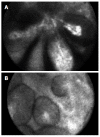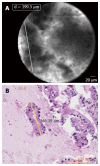Endoscopic ultrasonography: Transition towards the future of gastro-intestinal diseases
- PMID: 26855537
- PMCID: PMC4724609
- DOI: 10.3748/wjg.v22.i5.1779
Endoscopic ultrasonography: Transition towards the future of gastro-intestinal diseases
Abstract
Endoscopic ultrasonography (EUS) is a technique with an established role in the diagnosis and staging of gastro-intestinal tumors. In recent years, the spread of new devices dedicated to tissue sampling has improved the diagnostic accuracy of EUS fine-needle aspiration. The development of EUS-guided drainage of the bilio-pancreatic region and abdominal fluid collections has allowed EUS to evolve into an interventional tool that can replace more invasive procedures. Emerging techniques applying EUS in pancreatic cancer treatment and in celiac neurolysis have been described. Recently, confocal laser endomicroscopy has been applied to EUS as a promising technique for the in vivo histological diagnosis of gastro-intestinal, bilio-pancreatic and lymph node lesions. In this state-of-the-art review, we report the most recent data from the literature regarding EUS devices, interventional EUS, EUS-guided confocal laser endomicroscopy and EUS pancreatic cancer treatment, and we also provide an overview of their principles, clinical applications and limitations.
Keywords: Biliary drainage; Confocal laser endomicroscopy; Endoscopic ultrasonography; Endoscopic ultrasonography fine-needle aspiration; Pancreatic cancer treatment.
Figures





Similar articles
-
Pancreatobiliary drainage using the EUS-FNA technique: EUS-BD and EUS-PD.J Hepatobiliary Pancreat Surg. 2009;16(5):598-604. doi: 10.1007/s00534-009-0131-5. Epub 2009 Aug 1. J Hepatobiliary Pancreat Surg. 2009. PMID: 19649561 Review.
-
Endoscopic ultrasound in gastroenterology: from diagnosis to therapeutic implications.World J Gastroenterol. 2014 Jun 28;20(24):7801-7. doi: 10.3748/wjg.v20.i24.7801. World J Gastroenterol. 2014. PMID: 24976718 Free PMC article. Review.
-
Endoscopic ultrasound in clinical practice.Acta Gastroenterol Latinoam. 2008 Jun;38(2):146-51. Acta Gastroenterol Latinoam. 2008. PMID: 18697409 Review.
-
Applications of endoscopic ultrasound in pancreatic cancer.World J Gastroenterol. 2014 Jun 28;20(24):7808-18. doi: 10.3748/wjg.v20.i24.7808. World J Gastroenterol. 2014. PMID: 24976719 Free PMC article. Review.
-
The role of therapeutic endoscopic ultrasound now and for the future.Expert Rev Gastroenterol Hepatol. 2014 Sep;8(7):775-91. doi: 10.1586/17474124.2014.917953. Epub 2014 May 15. Expert Rev Gastroenterol Hepatol. 2014. PMID: 24830540 Review.
Cited by
-
Intranasal sufentanil combined with intranasal dexmedetomidine: A promising method for non-anesthesiologist sedation during endoscopic ultrasonography.World J Clin Cases. 2022 Aug 16;10(23):8428-8431. doi: 10.12998/wjcc.v10.i23.8428. World J Clin Cases. 2022. PMID: 36159524 Free PMC article.
-
Effects of arginine-glycine-aspartic acid peptide-conjugated quantum dots-induced photodynamic therapy on pancreatic carcinoma in vivo.Int J Nanomedicine. 2017 Apr 5;12:2769-2779. doi: 10.2147/IJN.S130799. eCollection 2017. Int J Nanomedicine. 2017. PMID: 28435257 Free PMC article.
-
Pancreaticobiliary endoscopic ultrasound in England 2007 to 2016: Changing practice and outcomes.Endosc Int Open. 2021 Nov 12;9(11):E1731-E1739. doi: 10.1055/a-1534-2558. eCollection 2021 Nov. Endosc Int Open. 2021. PMID: 34790537 Free PMC article.
References
-
- Kiesslich R, Goetz M, Vieth M, Galle PR, Neurath MF. Confocal laser endomicroscopy. Gastrointest Endosc Clin N Am. 2005;15:715–731. - PubMed
Publication types
MeSH terms
LinkOut - more resources
Full Text Sources
Other Literature Sources

